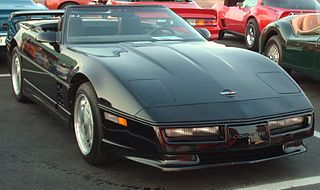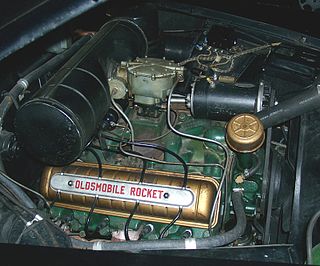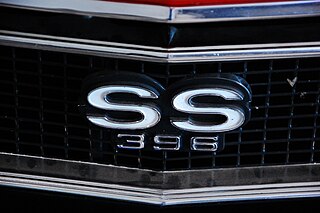Related Research Articles

The Chevrolet Corvette is a line of American two-door, two-seater sports cars manufactured and marketed by General Motors under the Chevrolet marque since 1953.

The Chevrolet Impala is a full-size car that was built by Chevrolet for model years 1958 to 1985, 1994 to 1996, and 2000 to 2020. The Impala was Chevrolet's popular flagship passenger car and was among the better-selling American-made automobiles in the United States.

The Chevrolet Chevelle is a mid-sized automobile that was produced by Chevrolet in three generations for the 1964 through 1977 model years. Part of the General Motors (GM) A-body platform, the Chevelle was one of Chevrolet's most successful nameplates. Body styles included coupes, sedans, convertibles, and station wagons. The "Super Sport" versions were produced through the 1973 model year and Lagunas from 1973 through to 1976.

The Chevrolet Bel Air is a full-size car produced by Chevrolet for the 1950–1981 model years. Initially, only the two-door hardtops in the Chevrolet model range were designated with the Bel Air name from 1950 to 1952. With the 1953 model year, the Bel Air name was changed from a designation for a unique body shape to a premium level of trim applied across a number of body styles. The Bel Air continued with various other trim level designations, and it had gone from a mid-level trim car to a budget fleet sedan when U.S. production ceased in 1975. Production continued in Canada, for its home market only, through the 1981 model year.

The Y platform, or Y body, designation has been used twice by the General Motors Corporation to describe a series of vehicles all built on the same basic body and sharing many parts and characteristics. The first was for a group of entry-level compacts including the conventional front-engine compacts built by GM divisions Buick, Oldsmobile and Pontiac from 1961 to 1963. The second, and current, incarnation is used for a high-end rear-wheel drive sports-car platform from the 1970s through the 2000s.

The General Motors LS-based small-block engines are a family of V8 and offshoot V6 engines designed and manufactured by American automotive company General Motors. First introduced in 1997, the family is a continuation of the earlier first- and second-generation Chevrolet small-block engine, of which over 100 million have been produced altogether, and is also considered to be one of the most popular V8 engines ever. Spanning three generations, a new, sixth generation is expected to enter production soon. Various small-block V8s were and still are available as crate engines.

The Chevrolet small-block engine is a series of gasoline-powered V8 automobile engines, produced by the Chevrolet division of General Motors between 1954 and 2003, using the same basic engine block. Referred to as a "small-block" for its size relative to the physically much larger Chevrolet big-block engines, the small-block family spanned from 262 cu in (4.3 L) to 400 cu in (6.6 L) in displacement. Engineer Ed Cole is credited with leading the design for this engine. The engine block and cylinder heads were cast at Saginaw Metal Casting Operations in Saginaw, Michigan.

The Oldsmobile V8, also referred to as the Rocket, is a series of engines that was produced by Oldsmobile from 1949 until 1990. The Rocket, along with the 1949 Cadillac V8, were the first post-war OHV crossflow cylinder head V8 engines produced by General Motors. Like all other GM divisions, Olds continued building its own V8 engine family for decades, adopting the corporate Chevrolet 350 small-block and Cadillac Northstar engine only in the 1990s. All Oldsmobile V8s were assembled at plants in Lansing, Michigan while the engine block and cylinder heads were cast at Saginaw Metal Casting Operations.

Super Sport, or SS, is the signature performance option package offered by the Chevrolet division of General Motors on a limited number of its vehicles. All SS models come with distinctive "SS" markings on their exterior. The SS package was first made available for the 1961 Impala. Some of the other models bearing the SS badge include the Camaro, Chevelle, El Camino, Impala, Monte Carlo, Nova and Chevrolet Pickup Trucks. Current SS models are produced by the GM Performance Division.

The 1957 Chevrolet is a car that was introduced by Chevrolet in September 1956 for the 1957 model year. It was available in three series models: the upscale Bel Air, the mid-range Two-Ten, and the economy/fleet model One-Fifty. A two-door station wagon, the Nomad, was produced as a Bel Air model. An upscale trim option called the Delray was available for Two-Ten 2-door sedans. It is a popular and sought after classic car. These vehicles are often restored to their original condition and sometimes modified. The car's image has been frequently used in toys, graphics, music, movies, and television. The '57 Chevy, as it is often known, is an auto icon.

The Chevrolet Corvette (C1) is the first generation of the Corvette sports car produced by Chevrolet. It was introduced late in the 1953 model year and produced through 1962. This generation is commonly referred to as the "solid-axle" generation, as the independent rear suspension did not appear until the 1963 Sting Ray.

The Chevrolet Corvette (C2) is the second-generation Corvette sports car, produced by the Chevrolet division of General Motors (GM) for the 1963 through 1967 model years.

The Chevrolet Corvette (C3) is the third generation of the Corvette sports car that was produced from 1967 until 1982 by Chevrolet for the 1968 to 1982 model years. Engines and chassis components were mostly carried over from the previous generation, but the body and interior were new. It set new sales records with 53,807 produced for the 1979 model year. The C3 is the third generation of the Chevrolet Corvette, and marks the second time the Corvette would carry the Stingray name, though only for the 1969–76 model years. This time it was a single word as opposed to Sting Ray as used for the 1963–67 C2 generation. The name would then be retired until 2014 when it returned with the release of the C7.

The Chevrolet Corvette (C4) is the fourth generation of the Corvette sports car, produced by American automobile manufacturer Chevrolet from 1983 until 1996. The convertible returned, as did higher performance engines, exemplified by the 375 hp (280 kW) LT5 found in the ZR1. In early March 1990, the ZR1 would set new records for the highest average speed over 24 hours at over 175 mph (282 km/h) and highest average speed over 5,000 miles at over 173 mph (278 km/h). With a completely new chassis, modern sleeker styling, and other improvements to the model, prices rose and sales declined. The last C4 was produced on June 20, 1996.

The third-generation Chevrolet Camaro is an American pony car which was introduced for the 1982 model year by Chevrolet. It continued to use General Motors' F-body platform and produced a "20th Anniversary Commemorative Edition" for 1987 and "25th Anniversary Heritage Edition" for 1992. These were also the first Camaros with factory fuel injection, four-speed automatic transmissions, five-speed manual transmissions, four-cylinder engines, 16-inch wheels, and hatchback bodies. For 1987 a convertible Camaro was reintroduced, converted by ASC in relatively small numbers. The third-generation Camaro continued through the 1992 model year.

The Corvette Stingray Racer is a sports racing car and concept car that debuted in 1959. The car was developed in the styling studios at General Motors (GM) at the behest of Bill Mitchell, GM Vice President of styling. The design was based on a sketch by designer Pete Brock, and was further developed by Larry Shinoda. The car strongly influenced the styling of the second generation (C2) Corvette Sting Ray.

The ChevroletCorvair Monza GT (XP-777) was a mid-engine experimental prototype automobile built by General Motors in 1962 and based on the early model Chevrolet Corvair series. As it was essentially a concept car, the Monza GT did not enter production.

The Chevrolet Corvette (C7) is the seventh generation of the Corvette sports car manufactured by American automobile manufacturer Chevrolet from 2014 until 2019. The first C7 Corvettes were delivered in the third quarter of 2013. The racing variants include the C7.R, which won the GTLM 24 Hours of Le Mans.

The Chevrolet El Morocco was a customized full-size car produced by Canadian businessman Reuben Allender based on the 1956 and 1957 Chevrolet. The relationship with Chevrolet began with Allender, a wealthy businessman who had built a business in the surplus textile industry and had a dream of building his own car. He was a long-time buyer of Cadillacs, with the ambition to build a smaller, lighter car that would be styled after them.

The Chevrolet Corvette SS is a sports racing car built by Chevrolet in 1957. The car raced once at the 1957 12 Hours of Sebring before Chevrolet withdrew from all racing activities in response to a ban that year by the Automobile Manufacturers Association for all of its member companies, which included GM.
References
- 1 2 3 Ernst, Kurt (2 March 2017). "After decades in the shadows, the 1957 Chevrolet Corvette Super Sport reemerges at Amelia Island". www.hemmings.com.
- 1 2 3 4 5 Mozzetta, Rich (March–May 2018). "Corvette Super Sport". Corvette Restorer.
- ↑ 1634–1699: McCusker, J. J. (1997). How Much Is That in Real Money? A Historical Price Index for Use as a Deflator of Money Values in the Economy of the United States: Addenda et Corrigenda (PDF). American Antiquarian Society. 1700–1799: McCusker, J. J. (1992). How Much Is That in Real Money? A Historical Price Index for Use as a Deflator of Money Values in the Economy of the United States (PDF). American Antiquarian Society. 1800–present: Federal Reserve Bank of Minneapolis. "Consumer Price Index (estimate) 1800–" . Retrieved February 29, 2024.
- 1 2 Golfen, Bob (1 March 2017). "Unique '57 Corvette prototype readied for Amelia Island Concours". journal.classiccars.com.
- ↑ "Looking Back at 1957s". www.chicagoautoshow.com. Retrieved 12 September 2019.
- ↑ Ouaknine, Joest Jonathan (4 March 2017). "La Corvette Super Sport de 1957 enfin restaurée" [The 1957 Corvette Super Sport finally restored]. www.leblogauto.com (in French).
- ↑ Carey, Rick (8 February 2022). "Mecum Kissimmee 2022, Where Records Fell". rickcarey.com.
- ↑ Markus, Frank (16 May 2006). "Consumer Feature: Corvette Timeline 1956-1992". www.motortrend.com.